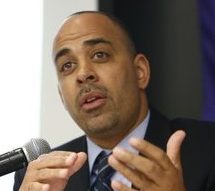![]() California has evolved from having one of the most draconian, costly juvenile justice systems to becoming a model of reform. There is still progress to be made, but the last few years of legislative gains are encouraging.
California has evolved from having one of the most draconian, costly juvenile justice systems to becoming a model of reform. There is still progress to be made, but the last few years of legislative gains are encouraging.
Under a progressive state legislature and the leadership of Gov. Jerry Brown, California has ushered in a staggering number of new laws to correct a flawed, punitive and dysfunctional youth justice system.

David Muhammad
Since 2014, the state legislature has passed and the governor signed into law bills automatically sealing juvenile records after successful completion of probation, outlawing the incarceration of youth for truancy, ending solitary confinement and significantly limiting the placement of youth in private residential facilities.
Senate Bill 9 was passed in 2013. It provides a second chance for youth who were under the age of 18 at the time of committing an offense for which they were sentenced as an adult to life in prison without the possibility of parole. The bill allows such youth to request a new sentencing hearing. This bill was later supported by U.S. Supreme Court rulings that outlawed automatic sentencing of children to life in prison.
SB 260, also passed in 2013, allows people incarcerated in California who were convicted as adults before their 18th birthday to have early parole board hearings and instructs the parole board to give “great weight” to the fact that the parole applicant was a child when they were convicted of their offense. The following year the legislature passed SB 261, extending SB 260 provisions to people convicted before their 23rd birthday.
In 2013, a large group of youth justice advocates formed a unified statewide coalition to transform the system. With an initial goal of ending the practice of placing youth in the adult system, the California Alliance for Youth and Community Justice (CAYCJ) was formed to “drastically reduce the number of incarcerated youth.” The Alliance was instrumental in the voter-approved ballot initiative Proposition 57. In addition to other important provisions, it eliminated the practice of direct file, which gave prosecutors the sole discretion of charging youth as adults and transferred that process to the courts.
2018 legislation
In the most recent legislative session, policymakers enacted additional measures that will further reform youth justice that go into effect this month. SB 439 limits juvenile justice jurisdiction to minors between ages 12 and 17, thereby ending the prosecution of youth younger than 12 in the juvenile justice system for all status and criminal delinquent acts except for the charges of murder or rape.
Another significant victory was the passage of SB 1391, eliminating any youth under the age of 16 being placed in the adult system.
These legislative successes continue California’s leadership in juvenile justice reform on the heels of an historic reduction in youth incarceration levels. Due to consistent advocacy efforts over two decades that produced class-action lawsuits, media exposure and a series of legislation since the late 1990s, the state juvenile justice system’s youth prison population has been reduced by more than 90 percent — from 10,000 youth inmates to now less than 600. County facilities throughout the state have also experienced steep declines, with 60 percent fewer youth in detention in the past 10 years.
California is fixing decades of ineffective, harmful and excessively expensive youth justice policies. We should be hopeful with the tremendous progress that has been made, but there still remain too many youth locked up in the state. A new, even more progressive governor taking office this month, along with inspired, organized advocates, presents the opportunity for a complete transformation of youth justice in California.
David Muhammad is the executive director of the National Institute for Criminal Justice Reform. He was formerly the co-director of the California Alliance for Youth and Community Justice, the former chief probation officer of Alameda County in California and the former deputy commissioner of probation in New York City.

This CA Juvenile System is still significantly flawed.
• A troubled youth is allowed to run away, be addicted and live on the streets for many months (with no serious attempt to locate him) because we are not allowed to ‘lock him up’.
• It is only while the youth is ‘held’ that meaningful treatment is possible, though meaningful & effective treatment is absent from the current system (at the county level), which is geared for short term holding of youth.
• A youth has ‘the right’ to kill himself on the streets with drugs and malnutrition because we cannot ‘detain him’ or ‘lock him up’ unless he is acting criminally.
• A youth with serious mental health issues can’t or won’t stabilize in a therapeutic group home where he literally comes and goes at will, because he can’t be stopped or restrained, but he is not allowed to go to a ‘locked or secure’, long term treatment facility where he might experience improvements.
• A youth with serious mental illness finally (thankfully) gets safely ‘secured’ in the County Juvenile System but an adequate placement remains un-locatable.
The youth’s case worker, attorney, state’s attorney and judge are changed at will, breaking down any continuity.
• While staying in a county Juvenile facility for an extended stay (keeping him safe) the youth with serious mental health issues is seriously pressured to join one gang or another. They threaten him and his family, the attack him and beat him, he is penalized by staff if he attempts to protect himself (fighting back), he gives in to the gang demands at times; all while he waits for a secure treatment setting and receives no meaningful services as he waits for months.
• There is no secure long-term treatment permitted in California for youth with serious mental illness and related problem behaviors. Ankle bracelets are easily removed and the youth is gone.
There are good, healthy reasons to be able to ‘secure a youth for an extended period and provide appropriate Mental Health and behavioral treatment. It works in the rest of the our nation and can work here.
We can do better. We must do better.